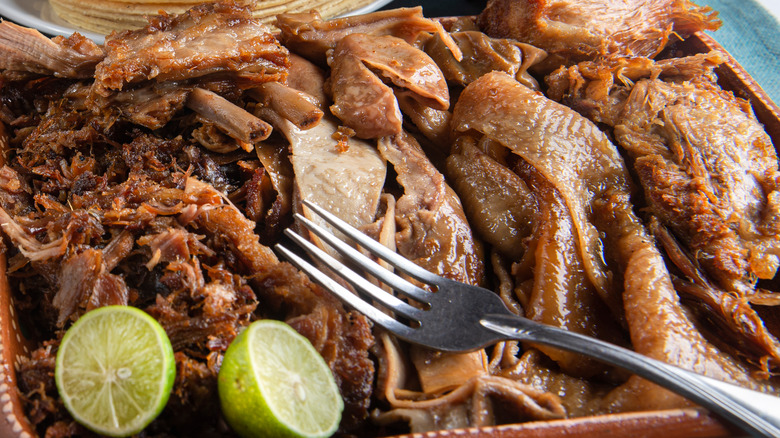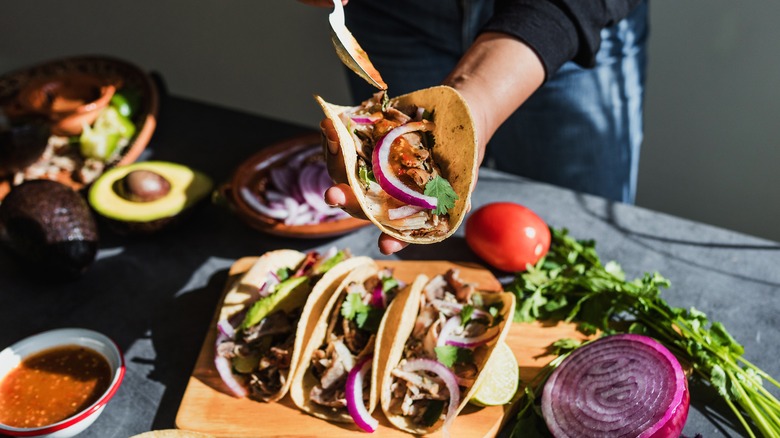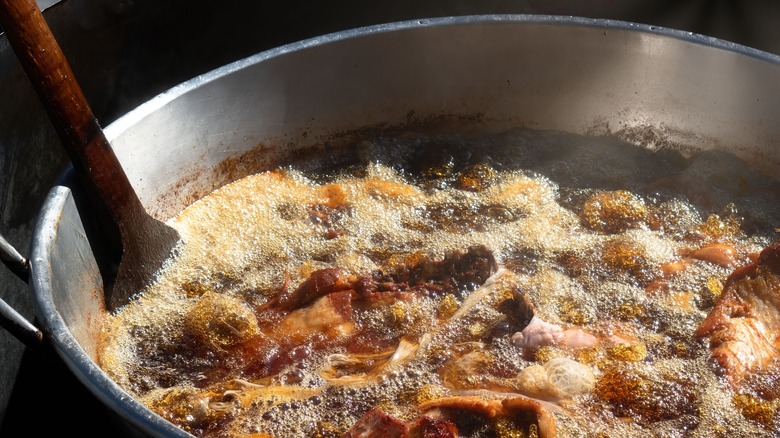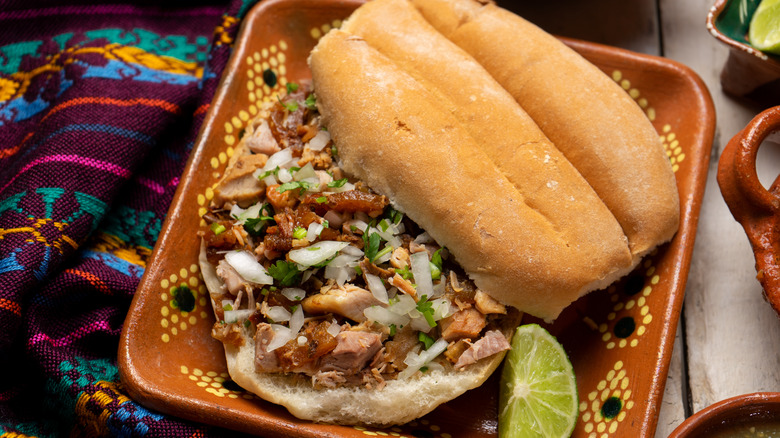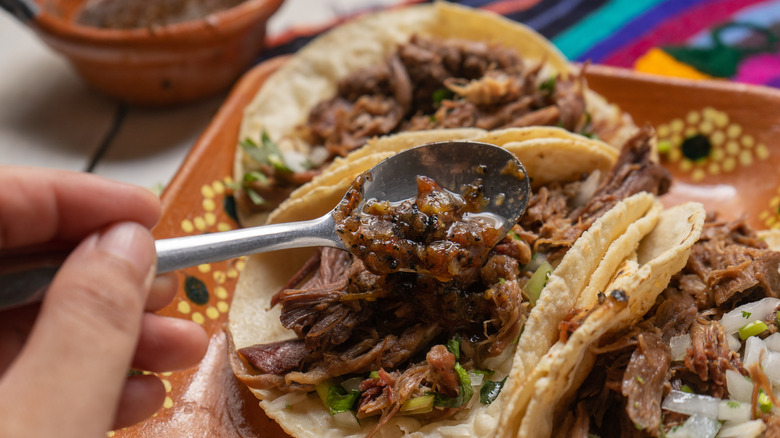What Is Carnitas And How Is It Different From Barbacoa?
Carnitas are undoubtedly one of the most celebrated taco fillings — it's hard to pass up some melt-in-your-mouth pork. While the most famous rendition hails from Michoacan, this dish is served in taquerias across Mexico and the U.S. Undeniably, carnitas take some time to come together, but they deliver a delicious result worthy of patience.
The food's secret is all in the fat — both the type contained in the pork cut and the lard it's slow-cooked in. Aromatics and spices boost the flavor, accompanied by surprising additions like milk and Coca-Cola. And once perfectly tender, a final blast of heat adds some crispy goodness.
After shredding, the pork may look similar to other meats — especially barbacoa — when in reality its preparation couldn't be more different. Loaded into tacos, tortas, enchiladas, and more, it's a meat dish that dependably hits the spot. Let's dive into what carnitas are all about.
Ingredients in carnitas
Like barbecue-style pulled pork, carnitas favor a large cut of pork with a substantial dose of fat. Various cuts of the shoulder are ideal — butt, picnic ham, shoulder roast, and other related areas. While some believe bone-in infuses extra flavor, it's not an essential requirement for the dish. The meat is slow-cooked in fat, typically a Mexican-style lard called Manteca, however, some substitute vegetable oil. In taquerias, the lard used for cooking is reserved for the next batch — adding an extra infusion of pork flavor.
When it comes to flavoring, aromatics including garlic, onion, bay leaves, oregano, and orange are stalwarts of the dish. Additional spices like cloves, cinnamon, cumin, and chili powder round out the flavor. While less common, some also add evaporated milk as a tenderizer for the pork and Coca-Cola as a sweetener. Chefs assemble varying components and ratios — no two batches of carnitas are identical.
How carnitas are made
In industrial settings, carnitas are cooked in huge vats of lard. The pork is first cut into chunks and browned on each side. Then, the heat is turned down, the aromatics are introduced, and the dish is slow-cooked for several hours. Once a palatable juicy consistency, it's shredded by hand or fork. Many then further toast the result in a hot pan or oven for a crispy texture.
It's difficult to replicate such a large-scale production in a home kitchen. A big part of carnitas' irresistible flavor come from seasoning that accrues in the vessel and the fat — meaning the first batch won't taste quite as good as subsequent ones.
If you're making carnitas at home, you can achieve a tender result by boiling the pork in a small amount of liquid or by tightly packing a pan and slow-cooking the meat in its own fat. Some also utilize a slow cooker for a tender result. Whichever method is utilized, pork must comprise most of the food's mass — otherwise, it won't have a concentrated carnitas flavor.
How to serve carnitas
Most often, carnitas are used as a filling for a delicious taco. They're bundled into flour or corn tortillas and topped with garnishes like onion, cilantro, radishes, lime, and sometimes guacamole. The accompanying salsa varies, but a bright and zesty tomatillo base is most frequent. Typically on the spicy, but not scorching side, the salsa is usually bolstered by the heat of jalapeño peppers. Some even simmer the tomatillo salsa in reserved pork liquid for a thoroughly combined pork flavor.
In addition to tacos, carnitas make for a popular sandwich filling — its juicy consistency perfectly meddling with refried beans, avocado, onions, and other combinations in a torta. And don't shy away from adding carnitas to a range of other dishes like quesadillas, enchiladas, empanadas, or into rice bowls. Plus, with a sizeable fat content, carnitas are delicious even after reheating. Simply freeze or refrigerate leftovers, and reheat them in a pan to enjoy after cooking.
How carnitas differs from barbacoa
Especially when stored side by side with other slow-cooked meats, it can be difficult to pinpoint carnitas. Its main distinguishing factor is its meat base — rather than beef used in barbacoa, carnitas are prepared from pork. Additionally, barbacoa utilizes a fire-based steaming method rather than a fat-based rendering. For the beef dish, the meat is traditionally wrapped in maguey leaves and cooked suspended over a liquid in an earth oven. The result generates both tender meat and a rich broth known as consommé.
Both types of meat are prepared in large quantities and built for sharing, especially on festive occasions. Frequently available at weekend markets, they're associated with a convivial atmosphere. Carnitas are available all around Mexico, but renditions from Michoacan are especially popular. Barbacoa is also ubiquitous but is more strongly associated with Central Mexico. It's hard to go wrong with either — but look for carnitas' more characteristic light color to tell the two apart.
